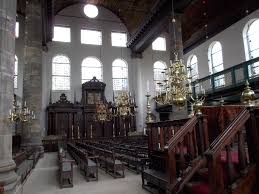
When you stand in the Esnoga, the massive Portuguese Synagogue in Amsterdam, built in 1675, you are aware that you are standing in one of the most remarkable places in the Jewish world. Standing there, alone, with a friend, as I did on a recent quiet Sunday morning, you can only gape at its ambition, its vaulted ceilings, its elaborate candelabras. (Its services are still only lit by candlelight.)
There isn’t a Jewish community anywhere quite like that in Amsterdam. There was little Jewish presence in the city before 1600. And then, as the Netherlands made its astonishing rise from minor Hapsburg dominion to the most powerful economic power in the world, Jews started to come in large numbers. Because of the Hapsburg connection, most of the Jews came from Portugal, and unlike any other Jewish community, before or since, it was largely comprised of new Jews, persons who hadn’t started their lives as Jews, but as conversos. They were primarily individuals who wanted to be Jewish, but really didn’t know much about their religion, and in this, two centuries before Jewish emancipation, they were the first modern Jewish community, having to find and create their traditions, rather than being born into one.
And soon afterwards, Ashkenazi Jews, from Germany, moved to Amsterdam in considerable numbers. (They also built a large synagogue, close to the Portuguese Synagogue. It was destroyed during the war, and is now partially restored.) The first modern Jewish community was located in the first modern capitalist society, and Jews fully participated in its bounty and its evils. Although they were not, as some might think, in the first rank of Amsterdam’s entrepreneurs, Jews fully participated in all of burgeoning business enterprises of the day, including the Dutch slave trade and establishing Jewish enclaves in (while it lasted) Dutch Brazil, the Dutch Caribbean, and New Amsterdam.
The most famous member of this community was the philosopher Baruch/Benidictus Spinoza. The main event in his life, of course, occurred in 1656, when the Sephardic community of Amsterdam pronounced a ferocious ban of cherem on Spinoza for his heretical views about religion. He thereafter refused to define himself either as a Jew but in a possible acknowledgement of his Jewish background, refused to define himself as a non-Jew either, thoroughly modern in his refusal avow any religion, but his own (highly rationalistic) form of spirituality, which he called the intellectual love of God. He was also surprisingly modern in his philosophy. He saw God and nature as one single, indivisible substance, impossible to divide, so ubiquitous that human freedom was impossible. It struck me that Spinoza’s superintending God was very much like our infinitely connected digital world, where every step and breath we take is monitored and surveilled. He would have been at home in 2016, both in our digital world and a world where we can choose and shape our religious, ethnic, and gender identies.
I also read Anne Frank’s diary last week. From Spinoza to Frank we can trace the bumpy course of Jewish modernity. I didn’t visit her house—I didn’t want to wait on a long line, and I preferred to celebrate Dutch Jewry rather than focus on its destruction, but the Holocaust and the legacy of the German occupation is everywhere in Amsterdam. No Jewish community in Western Europe suffered more than the Dutch Jews during the war. 76% of the over 100,000 Jews in the country perished, despite the lack of a formal ghetto, and a pre-war liberal society and government, a reminder, perhaps even more than Germany itself, how fragile is the democratic order. Her diary is the first work of Holocaust literature that became internationally famous but it really is a work of pre-Holocaust literature. Unlike the other most famous writers on the Holocaust, such as Elie Wiesel and Primo Levi, it is not about life in the camps. It is a book dedicated, as much as possible, to ignoring the Nazis. But the great irony of her diary is that reading it makes ignoring the Nazis, and the role that the Holocaust has played in shaping subsequent Jewish consciousness, impossible.
I also read, last week, the letters of Vincent Van Gogh, one of the most remarkable volumes of correspondence by any artist. Almost all of the letters are written to his brother Theo, and because Vincent did not save any of his brother’s letters, it is an almost entirely one-sided correspondence. Vincent comes across as a very intelligent, cultured (he is constantly talking about his interests in literature and music) person who, throughout his 20s, just couldn’t find his own way. Socially awkward, something of a ne’er-do-well, a failure in almost everything he attempted, you can feel him apologizing to Theo for, at age 27, with little formal training, trying to become an artist, acknowledging that it was probably just another shot in the dark. But of course he became one of the greatest of artists, compressing his career into a few short, furiously creative years. And of course the irony of his self-shortened life is that he never really enjoyed success, or had the feeling that he had “made it” as an artist, as he would have known had he lived for a few more years.
So what would these three most famous Dutch persons talk about when they met? They probably would speak about nature. Van Gogh would speak about how in his art he tried to express his innermost feelings through depicting nature, and felt himself becoming part of his landscapes. Spinoza would give a long philosophical talk, and try to explain that, properly understood, nature is God. Anne Frank would politely agree with both men, adding that only those who have spent years without touching a tree or a blade of glass, without feeling the wind on their skin or seeing the sun in their eyes, could really understand the beauty of nature.